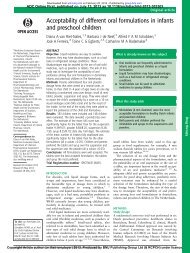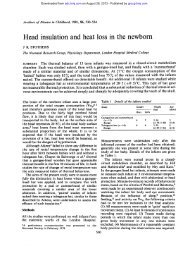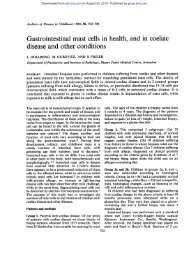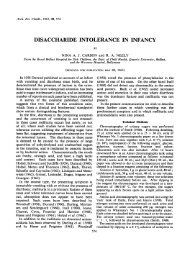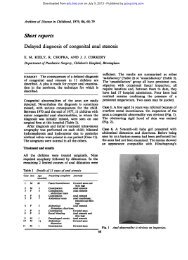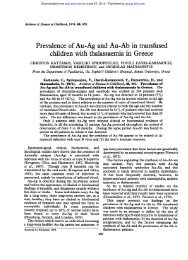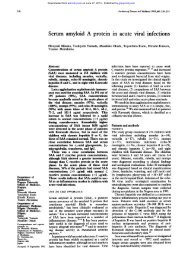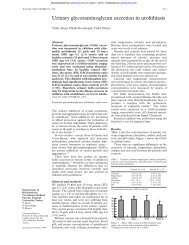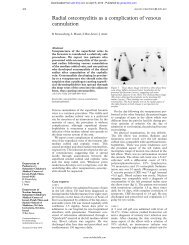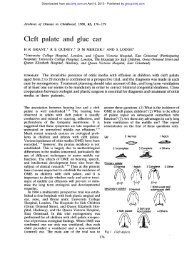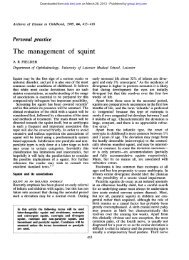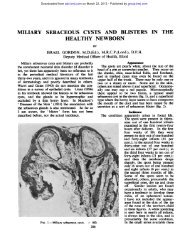Hypothesis of Menarche - Archives of Disease in Childhood
Hypothesis of Menarche - Archives of Disease in Childhood
Hypothesis of Menarche - Archives of Disease in Childhood
You also want an ePaper? Increase the reach of your titles
YUMPU automatically turns print PDFs into web optimized ePapers that Google loves.
<strong>Archives</strong> <strong>of</strong> <strong>Disease</strong> <strong>in</strong> <strong>Childhood</strong>, 1971, 46, 695.<br />
Height and Weight at <strong>Menarche</strong> and a<br />
<strong>Hypothesis</strong> <strong>of</strong> <strong>Menarche</strong><br />
ROSE E. FRISCH, and ROGER REVELLE<br />
From the Harvard Center for Population Studies, Cambridge, Mass., U.S.A.<br />
Frisch, R. E., and Revelle, R. (1971). <strong>Archives</strong> <strong>of</strong> <strong>Disease</strong> <strong>in</strong> <strong>Childhood</strong>, 46,<br />
695. Height and weight at menarche and a hypothesis <strong>of</strong> menarche.<br />
Height and weight at menarche were estimated by <strong>in</strong>terpolation <strong>of</strong> longitud<strong>in</strong>al<br />
growth data for 181 girls. Mean weight at menarche, about 48 kg, does not change<br />
as menarcheal age <strong>in</strong>creases, whereas mean height <strong>in</strong>creases significantly. Early<br />
and late menarcheal girls ga<strong>in</strong> the same amount <strong>of</strong> height, about 22 cm, and the<br />
same amount <strong>of</strong> weight, about 17 kg, <strong>in</strong> the <strong>in</strong>terval from the <strong>in</strong>itiation <strong>of</strong> the adolescent<br />
spurt to menarche, though late maturers grow at slower rates dur<strong>in</strong>g the spurt,<br />
<strong>in</strong>clud<strong>in</strong>g the year <strong>of</strong> menarche. A hypothesis <strong>of</strong> a direct relation between a critical<br />
weight and menarche is proposed. Such an <strong>in</strong>teraction would expla<strong>in</strong> the delay<strong>in</strong>g<br />
effect <strong>of</strong> malnutrition on menarche and the secular trend to an earlier menarche.<br />
Though there are many general observations that<br />
girls at menarche are taller and heavier than those<br />
<strong>of</strong> the same age who have not achieved menarche<br />
(Tanner, 1962), there are no published data on<br />
actual height and weight at menarche, as far as we<br />
know. In a prelim<strong>in</strong>ary report we gave data for<br />
height and weight at menarche obta<strong>in</strong>ed for each<br />
girl by <strong>in</strong>terpolation <strong>of</strong> the data <strong>of</strong> three longitud<strong>in</strong>al<br />
growth studies. At menarche, the mean weight <strong>of</strong><br />
early and late menarcheal girls did not differ,<br />
whereas late menarcheal girls were significantly<br />
taller than girls with early menarche (Frisch and<br />
Revelle, 1970).<br />
<strong>Menarche</strong> occurs after the <strong>in</strong>itiation <strong>of</strong> the adolescent<br />
growth spurt and the atta<strong>in</strong>ment <strong>of</strong> the maximum<br />
rates <strong>of</strong> growth <strong>in</strong> height and weight (Frisch<br />
and Revelle, 1969b; Simmons and Greulich, 1943).<br />
Our analysis <strong>of</strong> the same longitud<strong>in</strong>al growth<br />
studies for the height and weight <strong>of</strong> each child at<br />
the time <strong>of</strong> spurt <strong>in</strong>itiation (Frisch and Revelle,<br />
1971), and the maximum rates <strong>of</strong> growth (Frisch<br />
and Revelle, 1969b) also showed that the mean<br />
weight <strong>of</strong> early and late matur<strong>in</strong>g girls did not<br />
differ at each <strong>of</strong> these events, whereas late maturers<br />
were significantly taller at each event.<br />
These results account for the many observations<br />
that early maturers have more weight for height<br />
before, and throughout the adolescent spurt,<br />
<strong>in</strong>clud<strong>in</strong>g the year <strong>of</strong> menarche (Tanner, 1962).<br />
Received 16 March 1971.<br />
9A<br />
Downloaded from<br />
adc.bmj.com on April 2, 2013 - Published by group.bmj.com<br />
It was unexpected, however, that three <strong>of</strong> the major<br />
events <strong>of</strong> adolescence were related to an unchang<strong>in</strong>g<br />
mean weight.<br />
This paper gives additional f<strong>in</strong>d<strong>in</strong>gs <strong>of</strong> our analysis<br />
<strong>of</strong> height and weight at menarche as a function<br />
<strong>of</strong> age <strong>of</strong> menarche. A hypothesis <strong>of</strong> menarche<br />
and an explanation <strong>of</strong> the secular trend to an earlier<br />
menarche (Tanner, 1966; Marshall and Tanner,<br />
1968) are proposed.<br />
Method<br />
We are grateful to Dr. Robert McCammon and Dr.<br />
Charlotte Hansman <strong>of</strong> the University <strong>of</strong> Colorado<br />
Melical Center, Denver, Colorado, for transcripts <strong>of</strong><br />
the growth data <strong>of</strong> the Child Research Council (CRC),<br />
and to Dr. Isabelle Valadian and Dr. Robert Reed <strong>of</strong><br />
the Harvard School <strong>of</strong> Public Health (HSPH) for mak<strong>in</strong>g<br />
available the data from the Longitud<strong>in</strong>al Studies <strong>of</strong><br />
Child Health and Development, Harvard School <strong>of</strong><br />
Public Health. The data <strong>of</strong> the Berkley Guidance<br />
Study (BGS) are published <strong>in</strong> entirety (Tuddenham<br />
and Snyder, 1954).<br />
L The three growth studies are comparable. Height<br />
and weight measurements from birth to age 18, collected<br />
<strong>in</strong> the years from 1929 to 1950, were given for halfyearly<br />
(CRC, BGS, HSPH up to age 11) and yearly<br />
(HSPH, after age 11) <strong>in</strong>tervals. The socioeconomic<br />
status <strong>of</strong> the parents was average (HSPH) (Stuart,<br />
Reed et al., 1959), and above-average (BGS and CRC)<br />
(Tuddenham and Snyder, 1954; Dunlop, 1943).<br />
Age <strong>of</strong> menarche was recorded to the tenth <strong>of</strong> a year<br />
<strong>in</strong> the CRC and BGS studies and <strong>in</strong> months <strong>in</strong> the<br />
695
696<br />
Downloaded from<br />
adc.bmj.com on April 2, 2013 - Published by group.bmj.com<br />
HSPH study; the latter were converted to years and<br />
tenths <strong>of</strong> a year. Height and weight at menarche were<br />
estimated by <strong>in</strong>terpolation to the nearest tenth <strong>of</strong> a centimetre<br />
and tenth <strong>of</strong> a kilogram, respectively,for 181 girls <strong>of</strong><br />
the 201 girls <strong>in</strong> the studies. Interpolation was with<strong>in</strong> a<br />
half-year <strong>in</strong>terval for 71% <strong>of</strong> the girls, and with<strong>in</strong> a year<br />
<strong>in</strong>terval for the rema<strong>in</strong>der. Of the 20 girls omitted,<br />
3 had miss<strong>in</strong>g menarcheal dates; 3 (2 BGS, 1 HSPH)<br />
had weights at menarche greater than 70 kg, which a<br />
study <strong>of</strong> the distribution <strong>of</strong> menarcheal weights showed<br />
to be abnormal; and 14 were discarded (12 HSPH, 2<br />
CRC) because <strong>of</strong> growth data <strong>in</strong>tervals greater than a<br />
year at the menarcheal year. The means <strong>of</strong> age <strong>of</strong>men-<br />
Frisch and Revelle<br />
arche and height and weight at age 18 <strong>of</strong> the discarded<br />
girls did not differ significantly from those rema<strong>in</strong><strong>in</strong>g<br />
<strong>in</strong> the study.<br />
The height and weight ga<strong>in</strong>ed and the time <strong>in</strong>tervals<br />
from the <strong>in</strong>itiation <strong>of</strong> the adolescent height and weight<br />
spurts to menarche were found for each <strong>of</strong> 169 girls for<br />
whom data for both <strong>in</strong>itiation <strong>of</strong> the spurt and menarcheal<br />
height and weight were available.<br />
Result<br />
The mean age <strong>of</strong> all girls at menarche is 12-9<br />
0 * 09 years. Their mean weight at menarche is<br />
TABLE I<br />
Mean Height (Hmch) and Mean Weight (W<strong>in</strong>ch) at <strong>Menarche</strong>, and Height (H18) and Weight (W18) at Age 18<br />
<strong>of</strong> CRC, BGS, and HSPH Girls Grouped Accord<strong>in</strong>g to Age <strong>of</strong> <strong>Menarche</strong>, and For All Subjects<br />
<strong>Menarche</strong>al Growth No. Mean Age Mean Hmch Mean Wmch Mean H18 Mean W18<br />
Age Group (yr) Study (yr) Mch (cm) (kg) (cm) (kg)<br />
Up to and <strong>in</strong>clud<strong>in</strong>g CRC 10 11-3 155 -0 45 -8 164-9 58 -3<br />
11-9 SD 7-6 4-1 7-7 10-8<br />
BGS 15 11-4 157-8 50-0 167 -9 62-7<br />
SD 4-6 6-3 6-3 7 -7<br />
HSPH 10 11-5 155-5 46-9 163-8 57-0<br />
SD 4-5 7-1 4-8 6-7<br />
Total 35 11-4 156-4 47-9 165-9 59-5<br />
SD 5-7 6-5 6 -5 8-9<br />
12*0-12*9 CRC 17 12-3 159-1 49-1 167 -5 60*0<br />
SD 5 -5 8-3 4-6 9-1<br />
BGS 23 12-5 157-2 49-8 164-9 59 3<br />
SD 5 -0 7 0 5-2 7 -0<br />
HSPH 20 12-5 157-9 47-2 165-3 56-0<br />
SD 6-2 6 9 6-3 6-6<br />
Total 60 12*4 158 *0 48-7 165 *8 58*4<br />
SD 5 -6 7-4 5 -5 7 -7<br />
13*0-13*9 CRC 19 13*3 159 1 47 1 165 *4 55 -8<br />
SD 7-3 6-1 5 -9 6-0<br />
BGS 18 13-3 161-2 49*2 167-6 57 -8<br />
SD 7-6 7-3 5 9 6-3<br />
HSPH 17 13-4 156-8 45-1 162 -5 54-1<br />
SD 7-6 6-8 8-0 7-1<br />
Total 54 13*4 159*1 47*2 165 *2 55 *9<br />
SD 7-4 6-8 7 0 6-5<br />
14 * 0 and over CRC 16 14-3 162 *6 47 *5 168*0 54*7<br />
SD 8 1 6-4 7-7 9-0<br />
BGS 9 14-7 161-3 47-5 166-0 55 -3<br />
SD 9 *5 8-4 8 -7 8 -3<br />
HSPH 17 14-4 156-4 46-0 160-9 52-2<br />
SD 6 -7 5 -2 6-2 6-1<br />
Total 32 14*5 160*9 47*2 165 *8 54*3<br />
SD 7.9 6-8 7.9 7.9<br />
All subjects CRC 62 13.0* 159*3 47 *5 166*6 57*1<br />
SD 1.1 7-3 6-6 6-3 8-6<br />
BGS 65 12*8 159 *0 49*4 166*5 59-1<br />
SD 1-1 6-6 7-0 6 -3 7-4<br />
HSPH 54 12*8 156*9 46*3 163 *6 55 *1<br />
SD 0-96 6-4 6-6 6-7 6-7<br />
Total 181 12-9 158-5 47-8 * 165 -6 57-1<br />
SD 1-2 6-8 6-9 6-6 7 8<br />
* 13-17 years (no SE given) for all CRC girls <strong>of</strong> cont<strong>in</strong>u<strong>in</strong>g study (McCammon, 1965); 13-1 ± 0-12 years for sample <strong>of</strong> CRC girls <strong>in</strong><br />
study <strong>of</strong> <strong>in</strong>itiation <strong>of</strong> the adolescent spurt (Frisch and Revelle, 1971).
Height and Weight at <strong>Menarche</strong> and a <strong>Hypothesis</strong> <strong>of</strong> <strong>Menarche</strong><br />
0<br />
Wtmch S517-0-3 (±042)AAemch<br />
0 A I @ 0<br />
X<br />
0<br />
X<br />
A<br />
0<br />
X A 0 X<br />
AX X AX<br />
0 00 ° 0 x<br />
0 X0X 0 o<br />
go 0X<br />
Al X X<br />
X XA o x "OX<br />
X AiX AX 0<br />
0~~~~~~~~~<br />
A 00 o A X o o<br />
Ot xX oOxx o<br />
X Jo<br />
x - CRC<br />
o=BGS<br />
A = HSPH<br />
A X x it 0 X<br />
X X ^ o~~~<br />
i I I I I I I I I<br />
0 9 10 11 12 13 .14 IS 16<br />
Age <strong>of</strong> menarche (years)<br />
FIG. 1.-Weight at menarche (Wtmch) vs. age <strong>of</strong> menarche (Agemch) for CRC, BGS, and HSPH girls. Slope <strong>of</strong> regression<br />
l<strong>in</strong>e <strong>of</strong> Wtmch on Agemch does not differ significantly from zero (P> 0 50).<br />
47'8 i 0-51 kg, 84% <strong>of</strong> their mean weight at age<br />
18. Their mean height at menarche is 158 5 ±<br />
0-50 cm, 96% <strong>of</strong> their mean height at age 18. The<br />
mean weight does not change as menarcheal age<br />
<strong>in</strong>creases, whereas mean height <strong>in</strong>creases significantly<br />
(P
698<br />
0<br />
x<br />
Ao<br />
Xo<br />
a X X X 0<br />
x x<br />
x<br />
X o A<br />
a<br />
" X a o<br />
Xa<br />
A 0<br />
x<br />
x<br />
~~X<br />
x<br />
X<br />
0<br />
x<br />
x<br />
0<br />
0 x O 0 x<br />
OA x<br />
a x O X ^<br />
Ox x A O<br />
x x<br />
X O<br />
X<br />
x<br />
x<br />
& A<br />
o<br />
a<br />
o<br />
A<br />
0<br />
0<br />
A<br />
xA<br />
x<br />
Downloaded from<br />
adc.bmj.com on April 2, 2013 - Published by group.bmj.com<br />
180 -<br />
175 -<br />
170<br />
lbso<br />
165 -<br />
._ 155 -<br />
I<br />
150 -<br />
145 -<br />
140 -<br />
I1:35{<br />
0 0<br />
Frisch and Revelle<br />
Htmch21395+1 5 (±0-48) Aqemch<br />
xBCRCG|<br />
o=BGS<br />
A=HSPH<br />
P ___--i I I I -1<br />
9 10 11 1 12 13 14 15<br />
Age <strong>of</strong> menarche (years)<br />
FIG. 2.-Height at menarche (Htmch) vs. age <strong>of</strong> menarche for CRC, BGS, and HSPH girls.<br />
Htmch on Agemch differs significantly from zero (P
Downloaded from<br />
adc.bmj.com on April 2, 2013 - Published by group.bmj.com<br />
Height and Weight at <strong>Menarche</strong> and a <strong>Hypothesis</strong> <strong>of</strong> <strong>Menarche</strong> 699<br />
TABLE III<br />
Mean Height and Weight Ga<strong>in</strong>ed, and Mean Time Intervals from Age <strong>of</strong> Initiation <strong>of</strong> Height (age Hi) and<br />
Weight (age Wi) Spurts, Respectively to Age <strong>of</strong> <strong>Menarche</strong> (agemch) for CRC, BGS, and HSPH Girls Grouped<br />
Accord<strong>in</strong>g to Age <strong>of</strong> <strong>Menarche</strong><br />
Mean ± SE<br />
<strong>Menarche</strong>al Age Group No. -<br />
(yr) Hmch Less Hi Wmeb Less Wi Age Mch Less Age Mch Less<br />
(cm) (kg) Age Hi (yr) Age Wi (yr)<br />
Up to and <strong>in</strong>clud<strong>in</strong>g 11-9 31 21-6 ±097 16-8 i090 2-8 0-13 2-9 0-14<br />
12-0-12-9 55 21-3 0-79 17-6 0-78 3-1 0-12 3-3 0-11*<br />
13-0-13-9 52 22-8 i 0-63 16-7 ± 0-58 3-5 i 0-10t 3-4 + 0-13t<br />
14*0-14*9 31 21-1 ± 094 16-9 + 0-92 3*5 ± 0-14 3*7 + 0-18<br />
All subjects<br />
CRC 56 22-5 i 0-70 16-9 + 0-71 3-4 i 0-10 3-3 i 0-13<br />
BGS 61 22-3 0-72 17-5 0-68 3-3 0-11 3-4 0-11<br />
HSPH 52 20-7 ± 0-68 16-8 ± 0-65 3-1 ± 0-11 3-3 + 0-11<br />
*Difference from earliest group significant at P < 0-05.<br />
tDifference from earliest group significant at P
Downloaded from<br />
adc.bmj.com on April 2, 2013 - Published by group.bmj.com<br />
700 Frisch and Revelle<br />
It also may be significant that two other adolescent<br />
events, <strong>in</strong>itiation <strong>of</strong> the adolescent spurt<br />
and atta<strong>in</strong>ment <strong>of</strong> maximum rates <strong>of</strong> growth,<br />
take place for boys at mean weights 6 and 8 kg<br />
heavier, respectively, than that for girls (and two<br />
years later), but these weights are equivalent to<br />
the same average metabolic rate (cal/kg per day<br />
computed from Talbot's standards [Talbot, 1938])<br />
for each sex at each event (Frisch and Revelle,<br />
1969b, 1971). (The consistent weight and time<br />
difference between boys and girls at each adolescent<br />
event suggests that there may be a stage <strong>of</strong> sexual<br />
maturation <strong>in</strong> boys comparable to menarche <strong>in</strong><br />
girls occurr<strong>in</strong>g at a weight <strong>of</strong> about 55 kg at a mean<br />
age <strong>of</strong> 14 9 years.)<br />
Whatever the mechanism, the assumption that<br />
a critical body weight triggers menarche, can<br />
expla<strong>in</strong> simply many unexpla<strong>in</strong>ed observations associated<br />
with a late menarche. All such observations<br />
have <strong>in</strong> common that growth is slowed prenatally,<br />
postnatally, or both, so that the critical weight is<br />
reached at a later age: malnutrition delays menarche<br />
(Dreizen, Spirakis and Stone, 1967; Frisch and<br />
Revelle, 1969a); altitude delays menarche (Valsik<br />
et al., 1963; Valsik, 1965) (though the estimate <strong>of</strong><br />
three months per 100 m must be an error; per<br />
1000 m is reasonable); tw<strong>in</strong>s have later menarche<br />
than s<strong>in</strong>gletons <strong>of</strong> the same population (Tisserand-<br />
Perrier, 1953); later born sibs <strong>in</strong> a family have<br />
later menarche-they are smaller <strong>in</strong> height and<br />
weight than earlier sibs (Tanner, 1966).<br />
Conversely, observations <strong>of</strong> earlier menarche<br />
are associated with atta<strong>in</strong><strong>in</strong>g the critical weight<br />
more quickly: obese girls have menarche earlier<br />
than the average age (Donovan and van der Werff<br />
ten Bosch, 1965); and most important, the secular<br />
trend to an earlier menarche, about three to four<br />
months per decade <strong>in</strong> Europe <strong>in</strong> the last hundred<br />
years, is associated with an <strong>in</strong>crease <strong>in</strong> height and<br />
weight such that children <strong>of</strong> 11 at present are as<br />
large as children <strong>of</strong> 12, 30 or 40 years ago (Tanner,<br />
1966).<br />
Dur<strong>in</strong>g the <strong>in</strong>terval from spurt <strong>in</strong>itiation to<br />
menarche, the growth <strong>of</strong> the CRC girls was<br />
apparently not slowed by altitude: they ga<strong>in</strong>ed the<br />
same amount <strong>of</strong> height and weight <strong>in</strong> the same<br />
mean time as the BGS girls. S<strong>in</strong>ce the mean<br />
birthweight <strong>of</strong> the CRC girls was significantly<br />
lighter than that <strong>of</strong> the BGS girls, and the CRC<br />
girls grew more slowly from birth to <strong>in</strong>itiation <strong>of</strong><br />
the spurt (Frisch and Revelle, 1970, 1971), this<br />
f<strong>in</strong>d<strong>in</strong>g suggests that growth dur<strong>in</strong>g the adolescent<br />
spurt is controlled differently, or is somehow less<br />
affected by altitude, than is the <strong>in</strong>trauter<strong>in</strong>e and<br />
childhood growth before the spurt.<br />
Another possible explanation <strong>of</strong> this result is<br />
that postuter<strong>in</strong>e growth up to adolescence is not<br />
affected directly by altitude but is 'impr<strong>in</strong>ted' by<br />
the earlier <strong>in</strong>trauter<strong>in</strong>e retardation (Gifford et al.,<br />
1966) caused by altitude, <strong>in</strong> the same manner <strong>in</strong><br />
which limitation <strong>of</strong> food <strong>in</strong> the wean<strong>in</strong>g period<br />
affects later growth <strong>in</strong> the rat, or a closer analogy,<br />
<strong>in</strong> the way <strong>in</strong>trauter<strong>in</strong>e deprivation may affect<br />
subsequent growth rate <strong>in</strong> the pig (Widdowson<br />
and McCance, 1960). Adolescent growth may be<br />
<strong>in</strong>dependent <strong>of</strong> such 'impr<strong>in</strong>t<strong>in</strong>g'.<br />
The critical weight-menarche hypothesis and the<br />
proposed explanation <strong>of</strong> the secular trend could be<br />
tested by compar<strong>in</strong>g the weights <strong>of</strong> girls at menarche<br />
<strong>in</strong> this decade with the estimate <strong>of</strong> 48 kg two or<br />
three decades ago. Both would be supported if<br />
the mean weight at menarche has not changed<br />
while the age <strong>of</strong> menarche has become earlier.<br />
Accord<strong>in</strong>g to our hypothesis also, the secular trend<br />
to an earlier menarche should end when the weight<br />
<strong>of</strong> children <strong>of</strong> successive cohorts rema<strong>in</strong>s the same<br />
because <strong>of</strong> the atta<strong>in</strong>ment <strong>of</strong> maximum nutrition<br />
and child care.<br />
The simple, but potentially <strong>in</strong>terest<strong>in</strong>g, measurement<br />
<strong>of</strong> weight at menarche could be obta<strong>in</strong>ed <strong>in</strong><br />
prospective studies <strong>of</strong> menarche and ongo<strong>in</strong>g<br />
growth studies.<br />
We thank Mrs. Sole Cook for her assistance with the<br />
statistical computations.<br />
REFERENCES<br />
Boas, F. (1932). Studies <strong>in</strong> growth. Human Biology, 4, 307.<br />
Cheek, D. B., Graystone, J. E., Mellits, E. D., and Reba, R. C.<br />
(1969). Body composition: anthropometric growth and heat<br />
production. In Adolescent Nutrition and Growth, p. 163.<br />
Ed. by F. P. Heald. Appleton-Century-Cr<strong>of</strong>ts, New York;<br />
Butterworths, London.<br />
Donovan, B. T., and van der Werff ten Bosch, J. J. (1965). Physiology<br />
<strong>of</strong> Puberty, p. 31. Williams and Wilk<strong>in</strong>s, Baltimore;<br />
Arnold, London.<br />
Dreizen, S., Spirakis, C. N., and Stone, R. E. (1967). A comparison<br />
<strong>of</strong> skeletal growth and maturation <strong>in</strong> undernourished<br />
and well-nourished girls before and after menarche. Journal<br />
<strong>of</strong> Pediatrics, 70, 256.<br />
Dunlop, D. G. (1943). The families <strong>of</strong> the Child Research Council.<br />
Journal <strong>of</strong> Pediatrics, 22, 111.<br />
Frisch, R. E., and Revelle, R. (1969a). Variation <strong>in</strong> body weights<br />
and the age <strong>of</strong> the adolescent growth spurt among Lat<strong>in</strong> American<br />
and Asian populations, <strong>in</strong> relation to calorie supplies.<br />
Human Biology, 41, 185.<br />
Frisch, R. E., and Revelle, R. (1969b). The height and weight <strong>of</strong><br />
adolescent boys and girls at the time <strong>of</strong> peak velocity <strong>of</strong><br />
growth <strong>in</strong> height and weight: longitud<strong>in</strong>al data. Human<br />
Biology, 41, 536.<br />
Frisch, R. E., and Revelle, R. (1970). Height and weight at<br />
menarche and a hypothesis <strong>of</strong> critical body weights and adolescent<br />
events. Science, 169, 397.<br />
Frisch, R. E., and Revelle, R. (1971). The height and weight <strong>of</strong><br />
girls and boys at the time <strong>of</strong> <strong>in</strong>itiation <strong>of</strong> the adolescent growth<br />
spurt <strong>in</strong> height and weight and the relationship to menarche.<br />
Human Biology, 43, 140.<br />
Gifford, S., Murawski, B. J., Brazelton, T. B., and Young, G. C.<br />
(1966). Differences <strong>in</strong> <strong>in</strong>dividual development with<strong>in</strong> a pair<br />
<strong>of</strong> identical tw<strong>in</strong>s. International Journal <strong>of</strong> Psycho-Analysis,<br />
47, 261.
Downloaded from<br />
adc.bmj.com on April 2, 2013 - Published by group.bmj.com<br />
Height and Weight at <strong>Menarche</strong> and a <strong>Hypothesis</strong> <strong>of</strong> <strong>Menarche</strong> 701<br />
Kennedy, G. C., and Mitra, J. (1963). Body weight and food<br />
<strong>in</strong>take as <strong>in</strong>itiat<strong>in</strong>g factors for puberty <strong>in</strong> the rat. Journal <strong>of</strong><br />
Physiology, 166, 408.<br />
McCammon, R. W. (1965). Are boys and girls matur<strong>in</strong>g physically<br />
at earlier ages? American Journal <strong>of</strong> Public Health and the<br />
Nation's Health, 55, 103.<br />
Marshall, W. A., and Tanner, J. M. (1968). Growth and physiological<br />
development dur<strong>in</strong>g adolescence. Annual Review <strong>of</strong><br />
Medic<strong>in</strong>e, 19, 283.<br />
Richey, H. G. (1937). The relation <strong>of</strong> accelerated, normal and<br />
retarded puberty to the height and weight <strong>of</strong> school children.<br />
Monographs <strong>of</strong> the Society for Research <strong>in</strong> Child Development,<br />
2 (1).<br />
Shuttleworth, F. (1937). Sexual maturation and the physical<br />
growth <strong>of</strong> girls age 6 to 19. Monographs <strong>of</strong> the Society for<br />
Research <strong>in</strong> Child Development, 2 (5).<br />
Shuttleworth, F. K. (1939). The physical and mental growth <strong>of</strong><br />
girls and boys age 6 to 19 <strong>in</strong> relation to age at maximum growth.<br />
Monographs <strong>of</strong> the Society for Research <strong>in</strong> Child Development,<br />
4 (3).<br />
Simmons, K., and Greulich, W. W. (1943). <strong>Menarche</strong>al age and<br />
the height, weight, and skeletal age <strong>of</strong> girls age 7 to 17 years.<br />
J'ournal <strong>of</strong> Pediatrics, 22, 518.<br />
Stuart, H. C., Reed, R. B. et al. (1959). Child health and development<br />
(Longitud<strong>in</strong>al studies). Pediatrics, 24, 875.<br />
Talbot, F. B. (1938). Basal metabolism standards for children.<br />
American Journal <strong>of</strong> <strong>Disease</strong>s <strong>of</strong> Children, 55, 455.<br />
Tanner, J. M. (1962). Growth at Adolescence, 2nd ed., p. 95.<br />
Blackwell, Oxford.<br />
Tanner, J. M. (1966). The secular trend towards earlier physical<br />
maturation. Tijdschrift voor Sociale Geneeskunde, 44, 524.<br />
Tisserand-Perrier, M. (1953). ktude comparative de certa<strong>in</strong>s<br />
processus de croissance chez les jumeaux. Journal de G<strong>in</strong>itique<br />
Huma<strong>in</strong>e, 2, 87.<br />
Tuddenham, R. D., and Snyder, M. M. (1954). Physical growth<br />
<strong>of</strong> California boys and girls from birth to eighteen years.<br />
University <strong>of</strong> California Publications <strong>in</strong> Child Development, 1 (2).<br />
Vallik, J. A. (1965). The seasonal rhythm <strong>of</strong> menarche. Human<br />
Biology, 37, 75.<br />
Vallik, J. A., Stukovsk9, R., and Bernitovk, L. (1963). Quelques<br />
facteurs geographiques et sociaux ayant une <strong>in</strong>fluence sur<br />
l'age de la puberte. Biotypologie, 24, 109.<br />
Widdowson, E. M., and McCance, R. A. (1960). Some effects <strong>of</strong><br />
accelerat<strong>in</strong>g growth. I. General somatic development.<br />
Proceed<strong>in</strong>gs <strong>of</strong> the Royal Society. Series B. Biological Sciences,<br />
152, 188.<br />
Correspondence to Dr. R. E. Frisch, Harvard Center<br />
for Population Studies, 9 Bow Street, Cambridge,<br />
Massachusetts 02138, U.S.A.
Downloaded from<br />
adc.bmj.com on April 2, 2013 - Published by group.bmj.com<br />
References<br />
Email alert<strong>in</strong>g<br />
service<br />
Notes<br />
Height and weight at menarche<br />
and a hypothesis <strong>of</strong> menarche<br />
Rose E. Frisch and Roger Revelle<br />
Arch Dis Child 1971 46: 695-701<br />
doi: 10.1136/adc.46.249.695<br />
Updated <strong>in</strong>formation and services can be found at:<br />
http://adc.bmj.com/content/46/249/695<br />
These <strong>in</strong>clude:<br />
To request permissions go to:<br />
http://group.bmj.com/group/rights-licens<strong>in</strong>g/permissions<br />
To order repr<strong>in</strong>ts go to:<br />
http://journals.bmj.com/cgi/repr<strong>in</strong>tform<br />
To subscribe to BMJ go to:<br />
http://group.bmj.com/subscribe/<br />
Article cited <strong>in</strong>:<br />
http://adc.bmj.com/content/46/249/695#related-urls<br />
Receive free email alerts when new articles cite this<br />
article. Sign up <strong>in</strong> the box at the top right corner <strong>of</strong><br />
the onl<strong>in</strong>e article.



